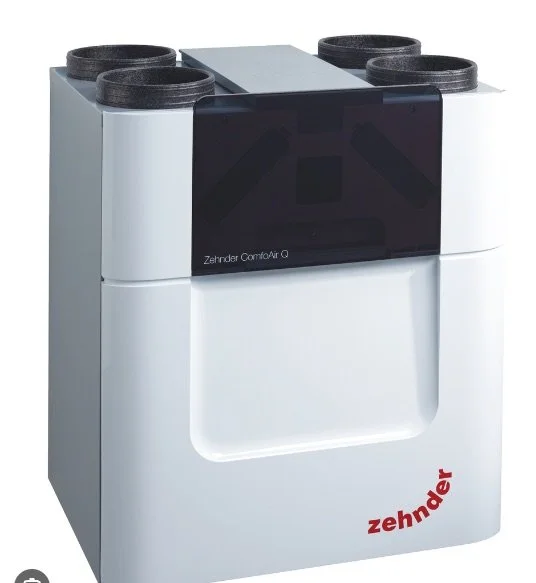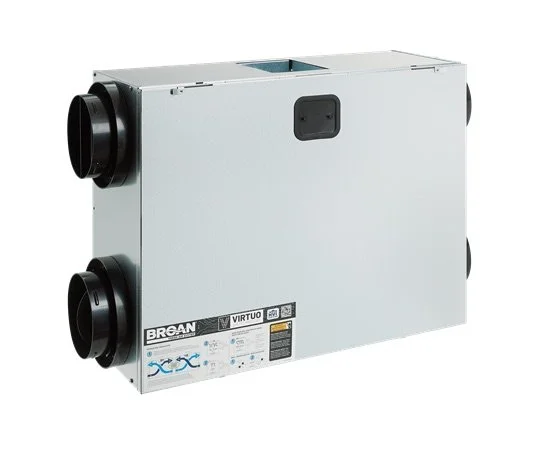Ventilation
Balanced ventilation is required by code in MA (2021 IECC Stretch Code) More importantly it promotes good air-quality and stable interior humidity. If you want a healthy and efficient home ‘build tight and ventilate right’.
We can recommend specific ventilation systems, review layout and duct designs from HVAC contractors, or provide input and eduction on how ventilation works with the other systems in your home.
There are two main pathways to ventilating a home: exhaust only ventilation and balanced ventilation.
ERV or HRV - Balanced Ventilation explained
If designed and installed right, these systems filter the air and recover energy . They have filters, heat exchangers and will distribute fresh air throughout the house. A ‘right sized’ system is set to run continuously at a low speed . Most systems have a function to ‘boost’ to a higher speed when the house is under greater occupancy.
Any high performance home should absolutely have one of these: homes with airtightness of 1 ACH50 or lower (our rule of thumb) . As the outgoing air transfers, or ‘recovers’ it’s energy to the incoming air, there is great energy efficiency gains with these systems, over the exhaust-only approach. The home will get credit in the HERS Rating for this recovery efficiency (offset slightly by the added electricity consumption)
With ample cooling systems sized properly for dehumidification , ERV is the better way to go in our Zone 5 climate in Western MA. ERV’s transfer moisture in addition to energy transfer.
Best Approach - The best indoor air-quality is achieved when fresh filtered air is delivered to specific areas in the home, and stale and/or moist air is exhausted from specific areas. This requires a dedicated duct system for the ventilation system. Best practices for supply and exhaust are:
Supply Fresh air: bedrooms, common/gathering spaces
Exhaust State air: bathrooms, kitchen, laundry rooms, ‘cat rooms’
A comprehensive ventilation duct system results in the healthiest airquality, a very simple system can be effective. Code does not stipulate extensive distribution.
We see some small homes with a single exhaust port near the kitchen, and a single supply port in the hallway outside of the bedrooms. This can aptly move air around a home and provide fresh air to passively enter sleeping areas.
Good Approach - Using the central duct system
If there is a central forced air duct system, the supply ducts can be used for ventilation Supply. The ventilaiton Exhaust then has it’s own ducts, perhaps to a bathroom and kitchen. This can work okay, but remember that the central duct work for heating/coolign is not optimized for delivering ventilation air, so duct sizes and port locations may not be ideal. See images below for more info.
Duct configurations - 3 ways to install balanced ventilation systems
Dedicated ventilation ducts -
best practice
The best air-quality is achievable with dedicated duct work for your ventilation system. With appropriate dampers/diffusers , specific airflow rates can be delivered and exhausted from specific locations through the home. We can help design and commission the airflow rates.
For example, a Master Bedroom (2 people sleeping) needs more fresh filtered air than a Guest Bedroom (irregular occupancy). Too much airflow in the kid’s bedroom may lead to air getting too dry or cool. With dedicated duct work , installed with controls, the best results can be designed and verified on site.
This is the approach that is recommended, though carries a higher cost.
Simplified Ducting - least ideal
The simplified form of ducting ERV/HRVs is not ideal. It requires that the airhandler is electrically connected to the ERV, adding to the energy used for the ventilation system. Moreover, this approach is near impossible to dial in ventilation rates to specific rooms and locations through the house. Short cycling of the ventilation air is possible if the air-handler is not operating properly. This is NOT Recommended, though is allowed by code and supported by some manufactures of ERVs.
Exhaust-ducted Approach - in between
This approach is the middle of the road approach. Dedicated exhaust ports exhaust stale air from the house. The fresh air uses the central duct system to ‘trickle’ the air into the house through all heat supply registers. This enable some control of the exhaust airflow rates, but does not enable dialing in fresh air supply rates. The air handler does not need to be electrically connected to the ERV/HRV for this approach.
The new Elite Plus (120 & 150) and the Elite (110 & 140 ) units are self balancing with updated digital controls.
Through their Swidget app syste, there is even a plug and play wifi module, for fully remote operation and control.
A simple ERV with great efficiency and mechanical controls. It is not self balancing, and requires commissioning by the install contractor or HERS Rater to ensure the house is not out of balance.
4. Zehnder and Brink Flair
This central ERV has excellent controls and speed adjustment capability. The duct layout can be simple, to move air around the house and provide a high level of ventilation in central areas. Or it can be comprehensive, providing fresh air in bedrooms and exhausting from wet areas of the home.
Note that for efficiency requriements, the units need to run at low fan speed. So opting for a larger unit, set on a lower speed is preferrable. The tighter the house, the more ventilation is needed.
Broan ‘AI’ series - 130E65 , 160E65 , or 210E75 . New - BLP150
2. Panasonic Intelli-balance Elite & Elite Plus -
This low cost ‘spot’ ERV is very simple. One line in , one line out. It provides NO air distribution through the house. It becomes exhaust only in freezing temperatures, as there is no defrost function. It is not rated for bathroom ventilation. Rated for 20 to 50CFM continuous with a 60CFM boost
The optional Broan VTTOUCH digital controller is highly recommended (digital controller pictured in video ) More info: https://www.broan-nutone.com/en-us/accessory/vttouchw
4. Lunos e2
This elegent tiny HRV, provides balanced ventilation for small spaces. European designed and built, there is no duct work so installation is very simple. More info by the US distributor, 475 . Flow rates up to 22 CFM per pair.
Save the best for last. These two European options are fitting for projects that want the very best in indoor air quality, at a price of course. The Zehnder and Brink units stand out as the best ERV available- at a premium price. They are super efficient, adjustable, smart, and quiet. They both feature home run ducts, making install not requiring sheetmetal installers. Brink offers a small FLAIR 225 unit, which is perfect for smaller 1bedrooms and ADUs, it goes up to 132 CFM .
Zehnder products
475 High Performance Building Supply specs, designs, and supplies the Brink ERV and HRVs.
Diffusers and dampers
There are various ways to design the distribution system - the delivery of fresh air, and exhaust of stale air, from the living spaces of the home. Having diffusers at the terminous of the duct into the room, can help adjust the ventilation rate to better best meet the needs of the occupants/ use of the space. In-line dampers placed in an accessible section the duct, can also adjust how much air is being delivered or exhausted from each duct branch.
Recommended diffusers:
Fantech CG4 - These 4” low cost diffusers thread in and out to adjust air flow. They are plastic , but don’t look ‘cheap’ . They also come in 5 and 6”
LifeBreath - LifeBreath has some nice grills and diffusers, including a ‘kitchen’ grill with a built in filter, which is great if there is no hood vent to outside and an ERV port in the kitchen.
Zehnder - The Luna-S supply and Luna-E exhaust diffusers are highly adjustable and very well made., on the higher end of the pricing range.
The NEW BLP150 ERV is really efficient and has a great form factor - can even be flush mounted in a ceiling with an access hatch. It is self balancing and provided 35-155 CFM (rated, before static losses) …a sweet spot for 1 bedroom to larger 2 bedroom houses.
The right ventilation equipment isn’t enough… is it working as designed?
Any system is only as good as it works.
Too often ventilation systems are not adjusted by the installation contractors. Why have a designed ventilation rate if you’re not going to verify that the ventilation rate is met; that the occupants will get the right amount of fresh air without over-ventilation, resulting in excess energy consumption?
We test ventilation systems at the Final HERS inspection. Upon request we can spend some more time and help balance and dial in the system to ensure it is running optimally to meet the needs of the occupants.
Adding diffusers at each supply and exhaust helps us dial in ventilation rates. The author has these simple Fantech CG4 grilles and they work great, though not as nice or costly as metal options available by Zehnder and Lifebreath (which is owned by Zehnder) .
Balanced and exhaust only ventilation take aways…
Ventilation system design can be very simple or complex.
Really good air quality and managed indoor humidity requires a well designed and specified balanced ventilation system.
You get what you pay for- low cost exhaust only ventilation won’t do much to ensure great indoor air-quality. Highly distributed balanced and filtered systems (ERV) do a lot more for indoor air-quality, though costs are significant ($3k-$10k)
Ventilation units and ducts need to be inside conditioned space
The homeowner/occupant needs to be know how to maintain the ventilation systems










